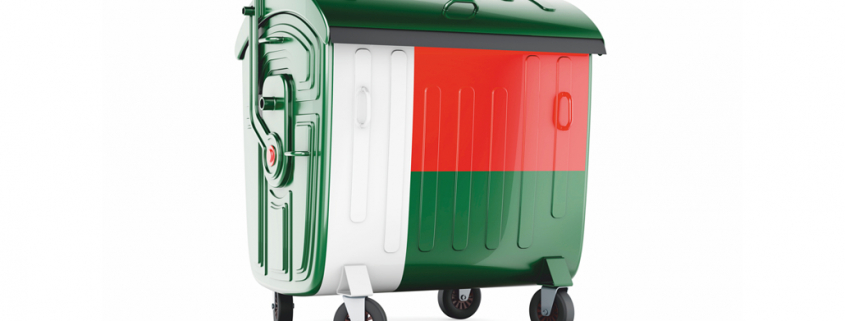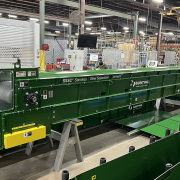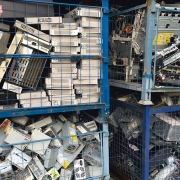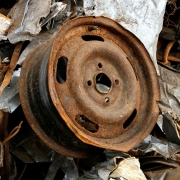Madagaskar – Enormous Natural Potential vs. Teething Troubles
“There are very few waste treatment facilities, such as incinerators that meet standards or sanitary landfills, and recycling activities are only at the beginning stage,” an inventory report by the Organisation of the United Nations for Industrial Development assessed in 2017. There are some decrees regulating waste management, but “with the exception of a few sites … with sanitary or controlled landfills, these waste management infrastructures are lacking in the other localities. The waste is deposited in wild dumps, which are for the most part ‚official dumps‘ for the districts.” What can be done to manage the Malagasy waste effectively and sustainably?
In 2010, the Service Autonome de Maintenance de la Ville d’ Antananarivo (SAMVA) was responsible for waste management and funded by a dedicated solid waste fee. The charge was tied to the property tax and the wastewater treatment fee; they were encashed by the electricity and water supply service company JIRAMA. As the collection rate of the solid waste fee was very low due to low property tax rates and JIRAMA refused to transfer the share, SAMVA turned out to be underfunded, underequipped and unable to provide a proper service. “A large portion of solid waste is thus disposed into illegal dumpsites or drainage channels”, the French Development Agency (AFD) judged.
No selective waste collection
In the same year, the French agency granted two million Euro to the Government of Madagascar to launch a project of seven years duration to restore the Andralanitra landfill, the only one dedicated to Madagascar’s capital Antananarivo. The aims were to limit leachate generation, improve the collection and exploitation of the landfill and prepare for the closing down of the landfill. The project – from July 2010 to June 2017 – was executed by collecting waste from 320 bins and transporting it with 35 rented trucks to Andranalitra. In 2016, 44 neighborhoods participated in pre-collection and a pilot project of composting was executed on the landfill to treat the organic fraction of the waste.
However, in 2016, the people of Madagascar’s capital Antananarivo generated about 500,000 tons of municipal solid waste, of which 261,186 tons respectively 53 percent were formally collected and disposed of. A “Solid Waste Management City Profile” of the Climate & Clean Air Coalition balanced: “There is no selective waste collection.”
Several attempts to increase collection and treatment
Some trials were done to develop Malagasy waste management. In 2017 for example, a Malagasy association developed an experimental project of urban waste valorization in Mahajanga, the third biggest town in Madagascar: Tananamadio tried to manage the local garbage dump by recycling part of the urban waste into organic products of agricultural interest. Engineers without Borders from the Netherlands together with Mety were working on establishing a waste management enterprise by an initial pilot project, which focuses on a low-income area in Antananarivo: For the pilot phase, Mety focused on collecting and processing food waste from markets and small restaurants into good quality fertilizer or biogas. At least 60 percent of all households in Toliara/Tuléar were expected to be connected to a functioning waste management system by 2017 and the number of unsanitary landfills was cut into halves, the German Welthungerhilfe gave account. (But the three proposed localities for a landfill were rejected, financial difficulties occurred, and the people hesitated to work voluntarily.)
65 percent remaining uncollected
In Tulear, instead, the local startup Greentsika launched a household waste collection service using digital tools in 2017 to handle collection date and fee; the German Welthungerhilfe realized the transportation of waste to landfills. And by the end of 2020, a consortium of five French specialized actors called Apis Solution started a project to upgrade waste management in Antananarivo – including capacity building and modernization of the waste management and recovery system by integrated management of the value chain as well as the recovery of biogas and compost to generate recurrent revenues. In other words: “Increasing the capacities of the pre-collection, collection, and waste sorting all the way to waste recovery, and landfill rehabilitation.” This seemed to be necessary at a certain point: In 2020, Engineers Without Borders still spoke of around 65 percent of waste remaining uncollected and 35 percent going to a landfill in Antananarivo. And the estimated volume of this landfill had meanwhile reached about 25 million tons.
Exports of waste and scrap are forbidden
In 2011, UNICEF found out that less than half of the municipal waste or rubbish produced in Madagascar each year was collected of which only 3.5 percent was composted, whilst the remaining 405,173 tons were dumped in landfills. The uncollected waste amounting to 419,000 tons per year was left untreated within the environment. A study by the Intergovernmental Oceanographic Commission and AFD in 2014 separated household waste into organic matter (60 percent), papers and cartons (13 percent), plastics (10 percent), glasses (4 percent), metals (2 percent) and others (11 percent). It also identified recyclable Malagasy waste per year comprising of 89,681 tons paper and cardboard, 68,985 tons of plastics, 13,797 tons of metal and 666 tons of tires. And there are several thousand tons of hazardous wastes like used mineral oils, batteries and accumulators, car batteries and refrigerants, ranging between about 7,000 and 500 tons. According to foreign trade marketing company GTAI (GermanyTrade and Invest), the export of waste and scrap, especially of aluminum and copper, is forbidden. So, what happens to Madagaskar’s waste that is not landfilled?
Creation with pieces of paper
In fact, there is some paper recycling in Madagaskar. The Société de Production d’article Hygienique (Spah) in Antananarivo is a specialist on the production of toilet paper made exclusively of cellulosic cotton wool from recycled paper sources. The company – once as “Papmad” a factory with 10,000 employees – has an output of one ton of wholly recycled toilet paper every year. It could be more, but first of all toilet paper is imported predominantly from China and secondly, only around seven percent of the population uses toilet paper because of a population with too little access to adequate sanitation. Another company using recycled paper waste is Newpack, headquartered in the capital city of Antananarivo. Founded in 1989, the company switched over to resource efficiency in 2009 “and the recycling and sales of paper waste”; in 2011 it installed a paper waste recovery system and a new water treatment plant.
Meanwhile, even ink sludge is treated. Today, Newpack runs “a sustainable environment policy by recycling of paper waste and wastewater treatment”. Admittedly, the production of paper packaging needs additional wood – FSC-certified. A small start-up named “Poti-taratasy Création” was born in 2016. The Malagasy name of the enterprise expresses the product: “Creation with pieces of paper”. According to the Relief Services paper, the enterprise selling bags made of recycled paper, cardboard or leather lacks financial capital and is unable to increase production due to a lack of infrastructure.
“Millions of plastic bags removed”
According to a paper of the Climate and Clean Air Coalition published in 2016, there are several companies that recycle plastic. Sacoplast, for example, concentrates on the recovery of materials like LDPE, HPE and PP for the production of bags, sachets, buckets and self-locking pavers. So does Vitaplast, a manufacturer of recycled or non-recycled products, that even wanted to start PET bottle recycling in 2022. Madacompost in his own words “removes millions of plastic bags from the city” and produces interlocking pavers from the material. The industrial group Société Malgache de transformation du Plastique (SMTP) is known for treating LDPE, HDPE, PVC and PPE and using it to make pipes and tanks. A paper of the Catholic Relief Services paper says that the company lacks materials for recycling, is confronted with too much waste sorting and possible investments are hampered by prices of raw materials and customs duties. The Societe d’Emballage de Madagascar (SEM) uses only a small percentage of recycled polypropylene to manufacture bags; the lack of investment breaks the possibility to use more recycled materials.
350 jobs in textile recycling
The Economic Development Board of Madagascar (EDBM) delivers additional information on textile recycling. One of the companies is Le Relais, the leader in France in the collection, sorting and recovery of textiles, but also present in Madagascar. The clothes sorting center Taratra based at Fianarantsoa has more than 100 employees and handles 350 tons of textiles per month. The center cooperates with Miezaka, bringing second-hand products to the market. According to EDBM, the company in Africa and Madagascar together created more than 350 jobs, recycles and exports between 2,000 and 3,500 tons per year, and only 15 percent of the collected textile end up as final waste. Another firm, high-quality brand Akanjo Madagascar, utilizes organic silk, recycled cashmere and dead materials in half of its collection’s ready-to-wear and is the only Malagasy textile industry certified ISO 26000 with three stars. And Epsilon – even as a developer and manufacturer of workwears, sportswears and children garments to the European market – not only recycles wastewater physico-chemically, biologically and phytologically: The enterprise reuses plastic waste, scraps of fabric as well as paper and wood and runs several trials with sludge and ash, cord waste and a vermicomposting system in order to recycle its organic waste.
WEEE, Covid-masks and EcoBricks
Madagascar additionally shows some more recycling approaches to industrial waste management. A Waste Electrical and Electronic Equipment Centre has been started in 2018, together with a Kenyan WEEE company cooperating in the creation of innovative practices for waste management related to urban mining and stimulating greater awareness among the public for the need to safely manage electronic waste. In 2020, the JRA University Hospital’s autoclave sterilized up to 210 kilograms of Covid-contaminated waste per day, 35 percent of the total waste treated. Four cycles were carried out daily for an appliance that would only run once every three days at usual times. The cement producer Holcim (Madagascar) S.A. had two production centers: an integrated plant with a capacity of producing 150,000 tons/year and a silo with a capacity of 180,000 tons/year. A study in 2019 tried to find the best mineralizer for that facility that could reduce the thermal energy expended in the formation of clinker while improving its quality. The aim of the research was “the promotion of Madagascar’s industrial waste and natural materials as clinker mineralizers”. But in 2021 Holcim agreed to sell the plant to to Cementis Océan Indien. Another initiative is EcoBricks, part of the Global Ecobrick Alliance, propagandizing EcoBrick as a PET plastic bottle filled with non-degradable waste and usable in building houses or the construction of a garden walls.
Lacks and obstacles
Following the before mentioned inventory report, in 2017, the Malagasy recycling industry took its first steps. “In fact, apart from a few large industrial units located in the Analamanga region, small businesses or associations carry out recycling activities, which, for the most part, are not yet registered in the formal system”. An article on “Mapping of available recycling/waste management infrastructure in Madagascar” edited by the Catholic Relief Services in early 2022 also puts a damper on too big industrial recycling expectations. After examining the scale and the waste management activities of several of the companies mentioned above, the paper shows a “lack of financial capital” as the major problem and the “lack of personnel working in the industry” as the second barrier to establishing small private or NGO companies. Obstacles for larger and industrial companies are in particular the gap between sorting workforce and the collected waste, the problematic search for the right type of recyclable waste and its necessary quantity. And finally: “Legal framework for waste management is for the moment flawed which means that the private sector is not necessarily inclined to invest in the field.”
Chemical use …
On the other hand, more than 70 percent of the Madagascan inhabitants are involved in agriculture. So, the country “has a large supply of organic materials and waste, coming mainly from the fruit industry”, the EDBM underlines. If – as shown – 60 percent of household waste consists of organics, of which a minimal fraction is composted, there must be a large number of agricultural by-products to be treated. The French National Research Institute for Sustainable Development proposed the incorporation of products from biomass in special chemicals and inaugurated an “International Joint Research Project”, investigating “chemical ecology”, “green chemistry” and “industrial ecology” focused on the recovery of regional biomass, as well as “bioactive molecules” from Malagasy biodiversity between 2019 and 2021.
… or energetic use?
Already in 2016, the École polytechnique fédérale de Lausanne published a master thesis on the “valorization of organic waste through anaerobic digestion in a rural municipality of Madagascar”. The feasibility study discovered the right size of 30-40 cubic meter for the plant, explained several fermentation modes, proposed sorting, grinding and pre-fermentation as pretreatment processes, and cleared up the different possibilities of the resulting biogas or digestate. Moreover, it suggested that the “ideal would be the combination of AD and composting to produce, besides the gas, solid biofertilizer for the farmers of the neighborhoods”. The author concluded, that this method “is a good option as it brings a decentralized solution for the treatment of 70 percent of the MSW (and can be combined with composting if quantities of waste are too big)”, especially as even the treatment of fecal sludge could be achieved. The potential was evaluated as huge, since “almost no rural municipalities in Madagascar have a waste management program, whereas it is part of their responsibilities”. Thus, the implementation of anaerobic digestion plants in rural areas was seen as “theoretically a very good and suitable idea”. But the implementation was considered “not so easy” because of high investment costs and the problem of sufficient gas production in poorer households.
A pleading for waste to energy
A group of Chinese researchers prefers another use of biomass. Ling Qin, Mengjun Wang, Jinfu Zhu, Yuhu Wei, Xintao Zhou, and Zheng showed in an article titled “Towards Circular Economy through Waste to Biomass Energy in Madagascar” in 2021 that the main form of biomass energy used in Madagascar is still wood and solid charcoal. Therefore, the Chinese researchers in their article pointed to the conversion of sources like farming residuals, animal wastes, forest wastes and urban or industrial organic waste to energy. They adverted to technologies like gasification, torrefaction or fermentation to produce biogas, bio coal briquette and ethanol fuel. Admittedly, the method of attaining biomass in Madagascar at the time must be considered as being in the earliest stage, not safe and unsustainable. But the study also alludes to financial and other support from China and Germany. In 2017 for example, China invested 71.20 million US-Dollar in Madagascar, “including a large portion in renewable energy industry”, according to the Economic and Commercial Counsellor’s Office of the Embassy of China in Madagascar. And the Regional Liquidity Support Facility (RLSF) fund – providing liquidity to independent power producers – was supported with 63.2 million US-Dollar from the German federal ministry for economic cooperation and development.
Biomass will play an underpart
There are two possibilities and offers to treat organic waste and residual products for the recovery of energy. The actual government is intent on stopping previous energy shortages by fostering energy and emission reduction programs. Hence, the Ministry of Water, Energy and Hydrocarbons is convinced that “Madagascar has considerable renewable energy resources (hydraulic, solar, wind, and biomass), while overall energy consumption remains very low” – i.e. 15 percent. Therefore, its “Investment Plan for renewable energy in Madagascar” includes the deployment of biomass as one strategy beneath other types of power. With a target of at least 75 percent renewable energy, the production “would be mainly based on hydroelectricity, but also on wind power, photovoltaic energy and biomass”. But biomass and (organic) waste will only play a minor role: Electricity and lightning will mainly be enabled by a power generation mix consisting of 75 percent hydroelectricity, 15 percent thermal, five percent wind, and five percent solar. Cooking – now engendered by 70 percent improved firewood or coal – will access 100 percent of sustainable-source wood. Biomass will only and especially be applied for commercial and industrial thermal use: “60 percent of businesses and industries will adopt effective measures by hydrocarbon and biomass use, compared to the currently almost non-existent penetration rate.” It is an open question, whether the burned “biomass” – at the moment mainly firewood with 68 percent and charcoal with ten percent – will really be treated applying organic “waste”.
The statement of Lloyd Bank is short and harsh: “There is no law prohibiting or limiting foreign investment in the country, but many obstacles make investment difficult. Madagascar has enormous natural potential, but the poor and costly quality of infrastructure, limited access to credit and financial instruments, as well as the poor definition of property titles, are all obstacles to investment. Political instability and corruption have blocked all public investment and caused the departure of many investors.”
(Published in GLOBAL RECYCLING Magazine 3/2022, Page 26, Photo: alexlmx / stock.adobe.com)








